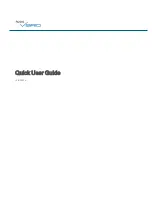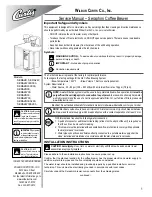
vii
INTRODUCTION
Electric Shock
(continued)
Fire and Explosion
Before installating, inspecting, or servicing equipment, disconnect
primary power and remove line fuses (or lock or red-tag
switches) to prevent accidental electric shock. Disconnect all
cables from welding power source and pull all 115V line-cord
plugs.
Do not open power circuit or change polarity while welding. If it
must be disconnected in an emergency, guard against shock
burns and flash from switch arcing.
Always shut off and disconnect all primary power when leaving
equipment unattended.
Primary power disconnect switch must be available near the
welding power source.
FIRE AND EXPLOSION
can be caused by hot slag, spatter,
sparks, extreme heat, misuse of compressed gases and cylinders,
and electrical short circuits.
Remove all combustibles from working area or provide a fire
watch. Avoid paint spray rooms, dip tanks, storage areas, venti-
lators. Move work to an area free of combustibles if possible. If
work cannot be moved, move combustibles at least 35 ft (10.7 m)
away from sparks and heat or protect against ignition with
suitable and snug-fitting, fire-resistant covers or shields.
Walls having combustibles on opposite sides should not be
welded on or cut. Walls, ceilings, and floor near work should be
protected by heat-resistant covers or shields.
A fire watch with suitable fire extinguishing equipment must be
provided during and after welding or cutting if combustibles
(including building construction) are within 35 ft (10.7 m), if
combustibles are further than 35 ft but may be ignited by flying
sparks, or if openings (concealed or visible) in floors or walls
within 35 ft may expose combustibles to sparks.
Combustibles adjacent to walls, ceilings, roofs, or metal partitions
can be ignited by radiant or conducted heat.
A hot work permit should be obtained before operation to ensure
supervisor’s approval that adequate precautions have been taken.
Do not weld or cut an empty container that has held combus-
tibles, or that can produce flammable or toxic vapors when
heated, unless container has first been cleaned as described in
AWS Standard A6.0. This includes a thorough steam or caustic
cleaning (or a solvent or water washing, depending on the
combustible’s solubility) followed by purging and inerting with
nitrogen or carbon dioxide, and using protective equipment as
recommended in A6.0. Waterfilling just below working level
may substitute for inerting.
IMPORTANT SAFETY PRECAUTIONS (continued)
Содержание 400 GTSW AC/DC
Страница 2: ......
Страница 46: ...OPERATION 28 NOTES ...












































